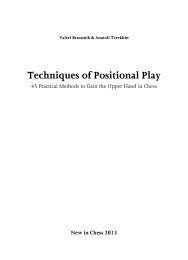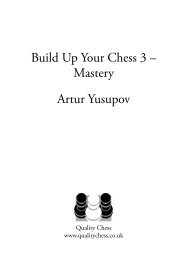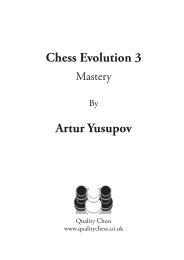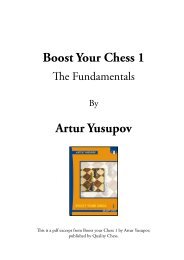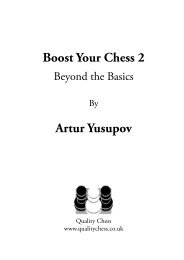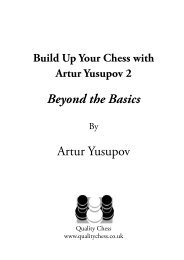Alexei Kornev A Practical White Repertoire with 1.d4 and 2.c4 ...
Alexei Kornev A Practical White Repertoire with 1.d4 and 2.c4 ...
Alexei Kornev A Practical White Repertoire with 1.d4 and 2.c4 ...
You also want an ePaper? Increase the reach of your titles
YUMPU automatically turns print PDFs into web optimized ePapers that Google loves.
Part 5. Slav Defence<strong>1.d4</strong> d5 <strong>2.c4</strong> c6 3.Nc318 The Winawer Counter-gambit 3...e5 . . . . . . . . . . . . . . . . . . . . . . . . . . . . . 20219 3...dxc4 . . . . . . . . . . . . . . . . . . . . . . . . . . . . . . . . . . . . . . . . . . . . . . . 20620 3...Nf6 4.e3 Bf5; 4...Bg4 . . . . . . . . . . . . . . . . . . . . . . . . . . . . . . . . . . . 21921 The Chebanenko variation 3...Nf6 4.e3 a6 . . . . . . . . . . . . . . . . . . . . . 22422 The Schlechter variation 3...Nf6 4.e3 g6 . . . . . . . . . . . . . . . . . . . . . 23523 3...Nf6 4.e3 e6 5.Nf3 a6 . . . . . . . . . . . . . . . . . . . . . . . . . . . . . . . . . . . 25424 Black avoids the main lines of the Meran variation3...Nf6 4.e3 e6 5.Nf3 Nbd7 6.Bd3 Bb4; 6...Bd6. . . . . . . . . . . . . . 27225 The Meran variation 3...Nf6 4.e3 e6 5.Nf3 Nbd76.Bd3 dxc4 7.Bxc4 b5 . . . . . . . . . . . . . . . . . . . . . . . . . . . . . . . . . 279Index of Variations . . . . . . . . . . . . . . . . . . . . . . . . . . . . . . . . . . . . . . 2996
PREFACESooner or later every chess player faces the problem of building hisor her opening repertoire. This is particularly difficult when you play<strong>with</strong> <strong>White</strong>, since you need to be well prepared against all of Black’spossible responses. However, most players, including the author, haveno inclination to devote all their time to studying opening variations.Therefore, we have decided not to cover the favourite opening move ofOstap Bender * – 1.e2-e4.As our main opening weapon for <strong>White</strong> we have chosen the closedopenings arising after 1.d2-d4, in which an underst<strong>and</strong>ing of chess<strong>and</strong> a knowledge of the typical resources in the middle game <strong>and</strong> theendgame are often much more important than a detailed knowledgeof a large number of variations. We have analysed the most straightforwardpossibilities for <strong>White</strong>, generally based on the development ofthe knight to c3 <strong>and</strong> the fastest possible occupation of the centre <strong>with</strong>pawns.Unfortunately it is impossible to cover all the possible theory after1.d2-d4 for <strong>White</strong> <strong>with</strong>in a single book, so the author plans to publishtwo further volumes.The first book is devoted to the move 1...d7-d5 for Black. I believethat the most challenging defences for <strong>White</strong> to face are the Queen’sGambit Accepted (Part 2), the Queen’s Gambit Declined (Part 4) <strong>and</strong>the Slav Defence (Part 5). A few less popular options for Black are coveredin Parts 1 <strong>and</strong> 3.---------* Ostap Bender is the picaresque hero of the hugely popular Russiancomic novel “The Twelve Chairs” (1928) by Ilf <strong>and</strong> Petrov. It is stillnot widely known in the West, despite the efforts of, for instance, MelBrooks, who made a film adaptation of it in 1970.7



